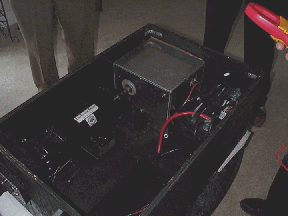
This prototype generator powered the inventor's home for three years
The New Universal Power Supply
How Does This New Generator Work?
This new generator device utilizes the generation of static electricity rather than cutting magnetic fields which has been common practice todate.

This prototype generator powered the inventor's home for three years
Existing magnetic flux generators have an efficiency of about 80% of the energy used employed in turning the generator's armature in order to generate electricity. Losses in boiler efficiency and in the steam turbine that rotates the armature increases the overall energy losses to approximately 50% of the raw energy of the fuel being utilized.
This NEW generating device has has an efficiency rate of 300%. In other words, for each unit of energy required to rotate the generator's shaft--three times that amount of energy in the form of electricity is produced when the generator is connected in parallel with a standard lead-acid battery (the same type of battery used in today's automobiles).
The static electricity from the generator keeps the batteries charged and the batteries supply direct current to an inverter that converts the direct current to 60 cycle alternating current (typical household current, or 220 volt, 50 cycle current as used in Europe). Some of the 110 Volt current is directed back to the motor turning the generator and the rest is available for other usage.
This driven static electricity generator would provide all the normal electrical requirements for an average household in the USA or elsewhere. It would also contain a motor speed control that matches the generator speed to that of the household electrical load - the greater the load the faster the generator runs - as the load drops the generator slows down.
This speed control and charge control keeps the batteries in a fully charged condition, resulting in an expected battery life of three (3) years or more. The direct operating cost for a household should be but the cost of replacing the batteries every three years! Approximately $25.00 per month!
This generating device weighs about six pounds without a case and about nine pounds with a case and its size is slightly smaller than a standard automobile battery.
A test is currently underway in which a shop - approximately 60' x 40' in dimension, is lighted and totally powered by the above described power unit containing eight standard 12V batteries. The shop contains an electric car hoist, lathe, drill press and the usual electric hand tools. The load averages three to five kilowatts at 110-volts AC. The peak load (car hoist operation) starting load is perhaps double that. There are also 14 twin 60 watt fluorescent light fixtures used for lighting - and they are not turned off. There is no external electric power connection to the shop.
A computer has been set up and the appropriate metering devices connected so that the computer will measure constantly, the current flow to the electric motor (1/2 HP) driving the generator; the output of the generator; output of batteries (if any) and output of the 10 kilowatts inverter, This test will be run for two weeks and the data should be available this month. A registered test engineer with a certified testing company will verify the accuracy of the measuring instruments. As is obvious from the above, the generator unit is completely non-polluting in all aspects - no fossil fuels are used to produce power. As reported to us, this small generator pack has produced 1 million watts of electricity in 12 days.
The requirement for new power plants plus transmission and distribution lines could be vastly reduced. It would appear logical that the existing electrical utilities would install this device in residential and small commercial establishments and lease and maintain as appropriate the facility, the existing billing and service units of the utility would be thus employed.
As is the case of this unique electrical generating system in residential and small commercial units, generator is completely non-polluting and environnentalty clean. No gasoline or diesel fuel exhast, no charging of batteries, etc.
The inventor has formed a company to handle this invention. Their plan is to sell the technology to appropriate organizations around the world that will manufacture and sell and/or lease the equipment as appropriate. A U.S. patent pending has been filed. As with all noteworthy inventions the technique in building these generators is fairly simple and much less complicated than designing and building a new type of internal combustion engine.
This report filed by Ed Anderson, Chairman of the Board of Minnesota Global, Inc. and Charles Sherlock, B.S. Engineering. Both have observed and measured the inputs and outputs of this new generator.
Date of this release: September 4, 2002
To contact us for further negotiations,Click here